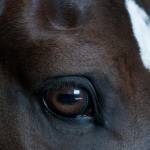Feeding for Good Behavior in Horses

Can you influence your horse’s behavior by tinkering with his feed management? The answer is, “Maybe sometimes, but not always for the better.”
Horses are creatures of habit, meaning they like the same things to happen at about the same times every day. Overall, they will be calmer if they are brought in, fed, exercised, and turned out on a steady schedule. Stall-kept horses like routine also, though they may not be turned out as part of each day’s activities. Horses that are used to being fed at 7:00 in the morning and 5:00 in the afternoon may get anxious if a feeding is skipped or arrives several hours later than normal. They may show their anxiety by circling their stalls, fidgeting, kicking, or whinnying. If you are planning to ride before a delayed feeding, your horse very likely won’t stand quietly to be groomed or tacked up, and your ride may not be incident-free. Owners might call this bad behavior, but the horse would explain that “My owner was late feeding me today and I didn’t like it.”
Even when they are fed grain meals right on time, some horses tend to get anxious or aggressive when they know their feed is on its way. They may charge into anyone who enters the stall with a feed bucket, and they can bite or kick if someone approaches while they are eating. Feeding smaller amounts in more frequent meals is one possible solution, as is switching the horse to an all-forage diet if he can maintain weight and energy on this plan. Horses usually aren’t as excited about getting more hay as they are about digging into a grain meal.
Horses that are pastured much of the time will nibble grass for hours, keeping a steady supply of saliva flowing. This saliva is a natural buffer of stomach acid, which can quickly ulcerate the stomach lining in horses that don’t eat for several hours at a time. Stalled horses may develop gastric ulcers because they often go for long stretches of time with nothing to nibble on. Keeping hay available to stalled horses helps to minimize the development of gastric ulcers. Horses with gastric ulcers may show signs such as a sour or dull attitude, resistance to working, or pinned ears when being tacked up. This is sometimes interpreted by owners as bad behavior, when actually the horse has a stomachache and doesn’t feel like exercising.
Many owners report that their horses have “grown a brain” after switching from a traditional high-carbohydrate concentrated feed to a low-carbohydrate product where more of the energy is delivered in the form of fat or oil. Though there is little clinical research to back up these owners’ claims of calmer behavior and better submission to the rider, the story has been heard enough times that many owners are convinced it is true. Certainly some horses seem more sensitive than others to the “sugar high” effect of feeds with a heavy carbohydrate component.
Supplements sold as calming agents contain various substances, some of which have been shown to smooth out behavior in some types of nervous or overexcited animals. Thiamine and magnesium are two ingredients that have been used successfully to reduce anxiety in some horses. Again, much of the evidence for some other products is anecdotal, indicating a lack of pure research and a suggestion that horses respond individually to ingested substances.
In general, many behavioral problems such as stall vices can be improved by giving the horse something to do instead of exhibiting the behavior. Providing free choice hay or increasing turnout can often relieve equine behavioral problems.
Behavior is influenced by a horse’s age, breed, gender, training, previous experiences, state of health, skill level of the handler, location, proximity to other horses, and such quickly changing factors as whether or not the wind is blowing. With so many variables, it’s wise to control the ones like feed type and schedule that can be relatively easily managed.








